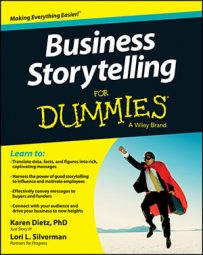There’s one thing you can do right away to improve your storytelling skills. It’s the most important quality in being able to be a fabulous storyteller. That single most important element is to listen.
The word storytelling is really inaccurate when talking about applying stories to your professional life. Storytelling creates a picture in our minds of someone standing up in front of a group of people in a presentation or meeting setting and telling a story. But telling a story is only half the equation. The other half is learning how to listen — and then doing it on a regular basis.
The beauty of storytelling is that it’s a co-created experience between the teller and the listener. Both are equally involved in the story, even in a large group setting. When you listen to a story, you’re actively internalizing the story and making sense of it in real time.
When working with stories in your organization, the first important principle to embrace is to avoid being solely a storyteller and become much more of a story listener. Deliberately asking for and consciously listening for stories should be your main focus.
That’s how you build relationships that weather the test of time, figure out how best to relay information to people, learn more about your internal and external customers’ needs and preferences, pick up on competitive intelligence information, and build loyalty.
People who feel deeply listened to and appreciated are the ones that move toward us; they want to sit in our radius and be nearer to us. Imagine what your department or organization would be like if it had customers who moved toward you, wanting to be in your sphere of influence.
Be in service to story and storyteller
To ready yourself to listen, take the position of being in total service to the storyteller. You want to listen the best story out of them as is humanly possible. You want to listen in such a way that the listener freely shares a story that is deep, rich, and satisfying.
Because storytelling is a joint activity, listening means stopping what you’re doing and giving your total attention to the other person for as long as it takes for them to tell the story.
You should also be in total service to the story itself. That means not interrupting the teller as the story is being shared. Be silent. Yes, this advice is contrary to most listening techniques (such as active listening, which involves paraphrasing what you heard and adding what you think the person is feeling at that moment in time).
Stories have a particular flow to them. When you interrupt the teller, two things happen:
You take over control of the conversation.
You stop the inherent flow of the story.
Don’t be concerned if the person is telling you the story out of order or seems to be skipping details you think you need.
When people get this kind of deep, appreciative listening, they freely open up. You might be amazed by the experience.
Reveal what’s in people’s hearts
When you deliberately listen for stories, people share information they never intended to reveal. They provide details you never knew to ask for. They may tell you what moved them, their deepest thoughts and feelings, and what the situation meant to them. You learn their emotional state, their need states, their values and mental models, and much more. This allows you to quickly get to the heart of the matter.
Why is this? When you request a story, and people share it with you, they relive the experience. When they relive it, they can’t help but attach once again to all the emotions they felt while the situation was unfolding in front of them. Now imagine what sort of impact this can have in building trust, working through difficult issues, and engaging others in change.
Uncover market, customer, and employee intelligence
When you’re listening for stories, all kinds of meaningful material will emerge. Asking for certain kinds of stories from specific people and market segments will gain you a wealth of information about your marketplace, your customers, your employees, and your own work. You’ll find out what makes your customers/prospects tick and discover the answers to who, what, why, where, when, and how questions without ever having to ask them.
Guesswork is removed because you’ll have a heightened understanding of competitor reputations, the motivations behind consumer behavior, and the real problems people are seeking to solve. All this material will inform both your business strategy and the tactical steps you need to put it into action.
Discover new ideas for products/services
Most companies think they need to conduct focus groups to learn about customer satisfaction, gain ideas about new products/services, or understand incremental improvements they can make to their products/services. But people in focus groups are seldom asked for stories, says Gerald Zaltman, the top guy in the field.
Zaltman’s approach takes a handful of people and individually spends time evoking and listening to their stories about a company’s product or service through a technique called the Zaltman Metaphor Elicitation Technique (ZMET).
Out of these sessions bubble up a wealth of ideas. The organization discovers what people really think, how they live their lives, the images and metaphors that guide them, and what they’re really seeking. These folks will even share ideas they get on their own for improvements.
Listening to these stories and the metaphors associated with them generates all kinds of creative ideas you can use in your work.
Organizations that don’t have an appreciation and a way to listen to customer stories end up shooting themselves in the foot and wondering why customers aren’t engaging with them. It’s because they don’t understand that the dynamics of storytelling requires a unique form of listening in return.

